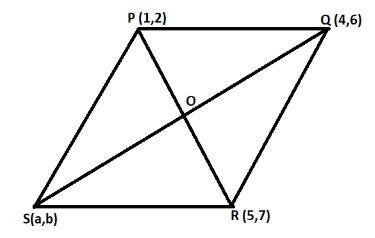
If P (1, 2), Q (4, 6), R (5, 7) and S (a, b) are the vertices of a parallelogram PQRS then
(a) a = 2, b = 4
(b) a = 3, b = 4
(c) a = 2, b = 3
(d) a = 3, b = 5
Answer
522.3k+ views
There is a property of a parallelogram. The two diagonals of a parallelogram bisect each other. So, using section formula, find the coordinates of mid - point of the both the diagonals and equate the two obtained coordinates.
Before proceeding with the question, we must know all the formulas that will be required to solve this question.
Let us consider a line $AC$ with a point $B$ lying on it. Let us assume that point $B$ is dividing this line $AC$ in ratio of $m:n$.

If the coordinates of $A$ is $\left( x',y' \right)$ and the coordinates of $C$ is $\left( x'',y'' \right)$, then, from the section formula, the coordinates of $B$ are,
\[\left( \dfrac{mx''+nx'}{m+n},\dfrac{my''+ny'}{m+n} \right)................\left( 1 \right)\]
In the question, we are given a parallelogram PQRS having vertices P (1, 2), Q (4, 6), R (5, 7) and S (a, b).

In a parallelogram, the two diagonals bisect each other. So, the point O is the mid - point of the diagonal PR and diagonal QS. This means that the point O divides the diagonal PR and diagonal QS in the ratio 1:1.
Using section formula $\left( 1 \right)$, the coordinate of O as a mid - point of PR is,
\[\begin{align}
& \left( \dfrac{1.5+1.1}{1+1},\dfrac{1.7+1.2}{1+1} \right) \\
& \Rightarrow \left( \dfrac{6}{2},\dfrac{9}{2} \right)................\left( 2 \right) \\
\end{align}\]
Using section formula $\left( 1 \right)$, the coordinate of O as a mid - point of QS is,
\[\begin{align}
& \left( \dfrac{1.a+1.4}{1+1},\dfrac{1.b+1.6}{1+1} \right) \\
& \Rightarrow \left( \dfrac{a+4}{2},\dfrac{b+6}{2} \right)..................\left( 3 \right) \\
\end{align}\]
Since coordinate $\left( 2 \right)$ and coordinate $\left( 3 \right)$ are the coordinate of the same of point i.e. O, we can equate x and y coordinate of coordinate $\left( 2 \right)$ and coordinate $\left( 3 \right)$.
Equating x coordinate, we get,
$\begin{align}
& \dfrac{a+4}{2}=\dfrac{6}{2} \\
& \Rightarrow a+4=6 \\
& \Rightarrow a=2 \\
\end{align}$
Equating y coordinate, we get,
$\begin{align}
& \dfrac{b+6}{2}=\dfrac{9}{2} \\
& \Rightarrow b+6=9 \\
& \Rightarrow b=3 \\
\end{align}$
Hence, the answer is option (c).
Note: There is a possibility that one may commit a mistake while drawing the parallelogram PQRS. Whenever we are given a parallelogram ABCD, the point A, B, C, D must be in clockwise or anticlockwise manner. If we plot these points in any random order, there is a possibility that we may get an incorrect answer.
Before proceeding with the question, we must know all the formulas that will be required to solve this question.
Let us consider a line $AC$ with a point $B$ lying on it. Let us assume that point $B$ is dividing this line $AC$ in ratio of $m:n$.

If the coordinates of $A$ is $\left( x',y' \right)$ and the coordinates of $C$ is $\left( x'',y'' \right)$, then, from the section formula, the coordinates of $B$ are,
\[\left( \dfrac{mx''+nx'}{m+n},\dfrac{my''+ny'}{m+n} \right)................\left( 1 \right)\]
In the question, we are given a parallelogram PQRS having vertices P (1, 2), Q (4, 6), R (5, 7) and S (a, b).

In a parallelogram, the two diagonals bisect each other. So, the point O is the mid - point of the diagonal PR and diagonal QS. This means that the point O divides the diagonal PR and diagonal QS in the ratio 1:1.
Using section formula $\left( 1 \right)$, the coordinate of O as a mid - point of PR is,
\[\begin{align}
& \left( \dfrac{1.5+1.1}{1+1},\dfrac{1.7+1.2}{1+1} \right) \\
& \Rightarrow \left( \dfrac{6}{2},\dfrac{9}{2} \right)................\left( 2 \right) \\
\end{align}\]
Using section formula $\left( 1 \right)$, the coordinate of O as a mid - point of QS is,
\[\begin{align}
& \left( \dfrac{1.a+1.4}{1+1},\dfrac{1.b+1.6}{1+1} \right) \\
& \Rightarrow \left( \dfrac{a+4}{2},\dfrac{b+6}{2} \right)..................\left( 3 \right) \\
\end{align}\]
Since coordinate $\left( 2 \right)$ and coordinate $\left( 3 \right)$ are the coordinate of the same of point i.e. O, we can equate x and y coordinate of coordinate $\left( 2 \right)$ and coordinate $\left( 3 \right)$.
Equating x coordinate, we get,
$\begin{align}
& \dfrac{a+4}{2}=\dfrac{6}{2} \\
& \Rightarrow a+4=6 \\
& \Rightarrow a=2 \\
\end{align}$
Equating y coordinate, we get,
$\begin{align}
& \dfrac{b+6}{2}=\dfrac{9}{2} \\
& \Rightarrow b+6=9 \\
& \Rightarrow b=3 \\
\end{align}$
Hence, the answer is option (c).
Note: There is a possibility that one may commit a mistake while drawing the parallelogram PQRS. Whenever we are given a parallelogram ABCD, the point A, B, C, D must be in clockwise or anticlockwise manner. If we plot these points in any random order, there is a possibility that we may get an incorrect answer.
Recently Updated Pages
Master Class 10 General Knowledge: Engaging Questions & Answers for Success

Master Class 10 Computer Science: Engaging Questions & Answers for Success

Master Class 10 Science: Engaging Questions & Answers for Success

Master Class 10 Social Science: Engaging Questions & Answers for Success

Master Class 10 Maths: Engaging Questions & Answers for Success

Master Class 10 English: Engaging Questions & Answers for Success

Trending doubts
Truly whole mankind is one was declared by the Kannada class 10 social science CBSE

Explain the three major features of the shiwaliks class 10 social science CBSE

Find the area of the minor segment of a circle of radius class 10 maths CBSE

Distinguish between the reserved forests and protected class 10 biology CBSE

A boat goes 24 km upstream and 28 km downstream in class 10 maths CBSE

A gulab jamun contains sugar syrup up to about 30 of class 10 maths CBSE




